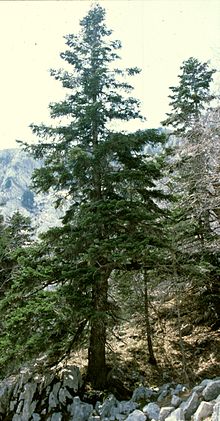| This article relies largely or entirely on a single source. Relevant discussion may be found on the talk page. Please help improve this article by introducing citations to additional sources. Find sources: "Dinaric calcareous block fir forest" – news · newspapers · books · scholar · JSTOR (December 2009) |



The dinaric calcareous silver fir forests are an endemic vegetation type of the littoral Dinaric Alps, located in the Dinaric Mountains mixed forests ecoregion in Southeastern Europe. Pure stands of dinaric calcareous silver fir (Abies alba) forests appear on limestone escarpments in the montane zones of Orjen, Velebit, Biokovo and Prenj. As an endemic and rare vegetation type of the Dinarides, they need protection.
Structure
Dinaric calcareous silver fir forests have an open structure which is environmentally sensible. As storms of bora and scirocco type are common in the coastal dinaric mountains, wind plays a great role in the formation of the highly labile structure in the pure silver fir communities. Silver firs can reach up to 35 metres (115 ft) on limestone and trunk diameters of 1 metre (3.3 ft) have been observed.
Distribution
Dinaric calcareous silver fir forests are dispersed in smaller patches on the hyperkarstic littoral karst mountain environments of the Dinarides. Prominent are those on Velebit and Orjen, appearing on bare limestone escarpments in the montane lifezone between 1,200–1,550 metres (3,940–5,090 ft). The abundance of precipitation on these coastal mountains of up to 5000 mm/ma with the dry soil conditions restricts these pure silver fir forests to the most rainy and humid spots of the Dinarides.
Ecology
Silver fir is a constituent of montane central European forests. As a rare species in dry climates of the Mediterranean, the silver firs presence on Mt. Orjen are restricted to humid northern slopes. A marked difference in the fir's vegetation patterns is seen here. It has a common cause in soil formation. High soil-water content in terrae fuscae on glacial superstratum leads to beech-fir forests, whereas dry initial rendzinas on glacio-karstic substrate support xeric dinaric calcareous silver fir forests. The latter endemic community rich in submediterranean species has evolutionary parallels with Bosnian Pine communities.
Floristic composition
Dinaric calcareous silver fir forests are among the most species-rich montane ecosystems in the Dinaric Alps.
Mixed deciduous-silver fir peony (Paeonia daurica Andrews)-forests with Paeonia daurica' have the most species rich composition found so far on Orjen (Abies alba, Corylus colurna, Fraxinus excelsior, Fagus sylvatica, Acer intermedium, Tilia cordata, Acer pseudoplatanus, Pinus heldreichii).
* Syntaxonomic chart of mixed deciduous-silver fir-peony forest at Orjen
Plant list
Typical plants of the many times dry basic Kalkomelasol soil plant Biotope:
C. OREOHERZOGIO-ABIETALIA Fuk. 1969
a) O r e o h e r z o g i o-A b i e t i o n Ht. emend. Fuk.
1. Oreoherzogio-Abietetum Fuk.
References
| This article includes a list of references, related reading, or external links, but its sources remain unclear because it lacks inline citations. Please help improve this article by introducing more precise citations. (July 2024) (Learn how and when to remove this message) |
- Pavle Cikovac: Sociology and ecology of silver fir forests on Mt. Orjen - Montenegro. LMU Munich 2002, Department of Geography